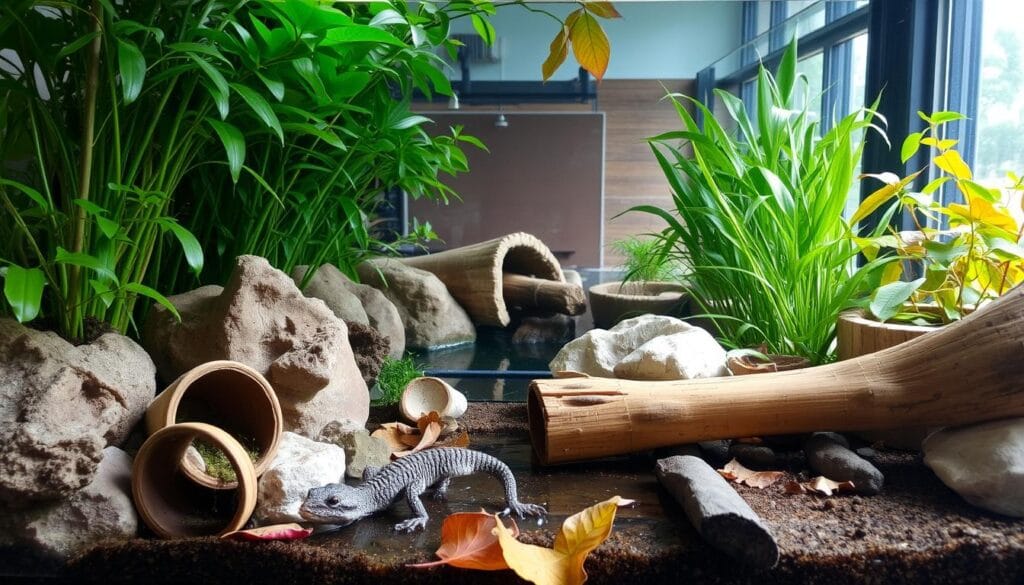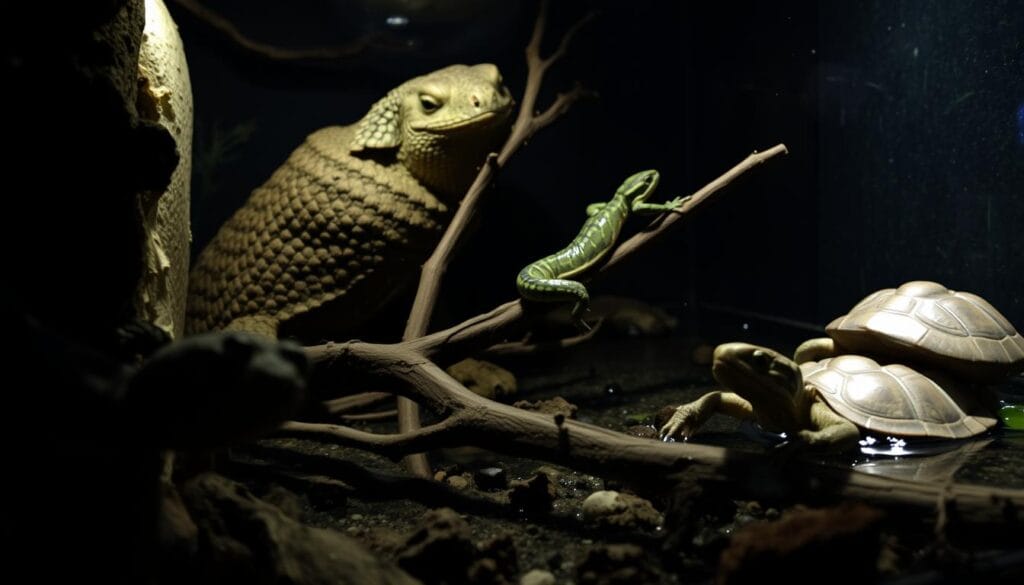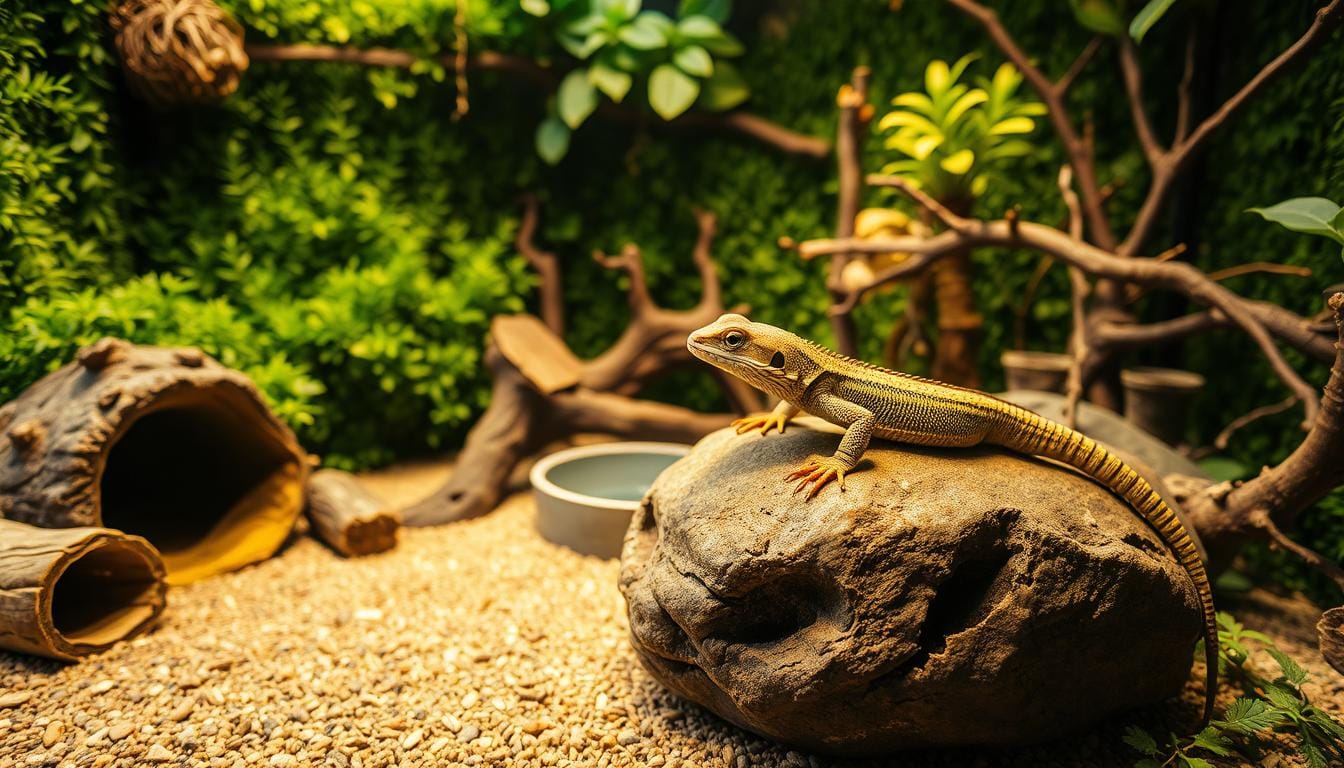As a reptile owner, I’ve learned that a stimulating environment is key. Without it, reptiles can get stressed and develop bad behaviors. This is why making your terrarium interactive is so important.
Adding interactive elements to your terrarium can greatly improve your pet’s life. It also helps you bond with them. Let’s look at some ways to make your terrarium more fun and engaging.
Table of Contents
Understanding the Importance of Enrichment for Reptiles
Reptile lovers are now focusing on enrichment to better their pets’ lives. Enrichment means making an animal’s space more interesting to keep it happy and healthy. By learning about enrichment, reptile owners can make their pets’ lives more fun and interactive.
What is Enrichment?
Enrichment means making a reptile’s home more exciting. This can be done by adding new things, rearranging the space, or introducing new smells and sights. For example, adding different hiding spots and climbing areas can really improve a reptile’s home.
A reptile expert says, “Enrichment is more than just a comfy home. It’s about making a space that challenges and keeps your reptile engaged, which is good for its health and happiness.”
“The goal of enrichment is to stimulate the animal’s natural behavior, reducing stress and boredom.”
Benefits of Environmental Enrichment
Environmental enrichment has many benefits for reptiles. It can lower stress, increase activity, and encourage natural behaviors. A stimulating environment helps reptiles thrive and show their natural side.
| Benefits | Description |
|---|---|
| Reduced Stress | Enrichment activities help minimize stress by providing a more engaging environment. |
| Increased Activity | A stimulating environment encourages reptiles to be more active, promoting physical health. |
| Promoting Natural Behaviors | Enrichment helps reptiles exhibit their natural behaviors, enhancing their mental and physical well-being. |
How Enrichment Impacts Behavior
Enrichment greatly affects reptile behavior. It can reduce abnormal behaviors and encourage natural ones. For example, a varied and changing environment can help stop pacing, a sign of stress in reptiles.
By adding fun activities and changing the environment, owners can keep their reptiles happy and active. This not only makes their lives better but also strengthens the bond between the reptile and its owner.
Creating a Naturalistic Habitat
A naturalistic habitat can greatly improve your reptile’s life. It gives them a sense of security and encourages natural behaviors. To make this happen, focus on a few key elements.
Selecting the Right Substrate
The substrate is the material at the bottom of your reptile’s terrarium. It must be safe, comfortable, and right for your reptile. For example, some need a moist substrate like sphagnum moss. Others prefer a drier one, like sand or calcium sand.
- Sphagnum moss for high humidity environments
- Calcium sand for desert-dwelling reptiles
- Reptile carpet for easy cleaning and comfort
Incorporating Live Plants
Live plants are key in a naturalistic habitat. They make the terrarium look better and offer benefits like better air and humidity. Good plants include Pothos, Snake Plant, and Dracaena. Make sure these plants are safe for your reptile and fit well in the terrarium.
Designing for Climbing and Hiding
Reptiles need places to climb and hide to feel safe. Adding branches, rocks, and decorations helps. They also need hiding spots, like caves or dense plants, to reduce stress.
“Providing a variety of climbing structures and hiding places can significantly reduce stress in reptiles and encourage natural behaviors.”
For climbing structures, consider:
- Branching wood
- Rocks and boulders
- Commercial climbing walls
By choosing the right substrate, adding live plants, and designing for climbing and hiding, you can create a naturalistic habitat. This will greatly enrich your reptile’s life.
Interactive Elements for Your Terrarium
It’s important to make your reptile’s home fun and engaging. Adding interactive elements is a great way to do this. These elements help your reptile stay active and happy.
Hiding Spots and Shelters
It’s key to give your reptile places to hide and feel safe. You can use rocks, plants, or special hiding caves for this. Having many hiding spots helps your reptile feel less stressed and more curious.
Here are some ideas for hiding spots:
- Use big rocks or boulders as hiding caves
- Add plants with thick leaves for hiding spots
- Place special hiding caves or boxes around
Water Features: Fountains and Ponds
Adding water features like fountains and ponds can make your terrarium more interesting. They provide water for your reptile and add to the beauty of the space. Fountains create a calming sound, while ponds let your reptile drink and maybe even swim.
Remember these tips when adding water features:
- Keep the water clean to avoid germs.
- Make sure your reptile can’t drown or get stuck.
- Watch the humidity in your terrarium, as water can make it higher.
Interactive Toys: Balls and Mirrors
Interactive toys like balls and mirrors make your terrarium more fun. Reptile toys like these keep your reptile active and interested. They also help mimic natural hunting behaviors.
Here are some interactive reptile toys you can try:
- Balls for your reptile to play with
- Mirrors to make it seem like there’s another reptile
- Special toys made just for reptiles
By adding these interactive elements, you can make your reptile’s home more exciting. This improves their happiness and health.
Utilizing Texture in the Habitat
Creating a good home for your reptile is more than just the right temperature and light. It also means adding different textures. A terrarium with varied surfaces can really improve your reptile’s life. It gives them chances to explore and stay active.
Varied Surfaces: Rocks, Wood, and Logs
Adding rocks, wood, and logs to your terrarium is a smart move. These elements add beauty and give your reptile places to climb and bask. For example, rocks can make a cozy spot for basking. Logs can be hiding spots or places to climb.
Soft vs. Hard Shelter Options
It’s important to have both soft and hard places for your reptile to hide. Soft spots, like leaf litter or moss, offer comfort and safety. Hard places, like rock caves or wooden dens, protect them and keep their nails healthy.
Importance of Temperature Variation
Having different temperatures in your terrarium is key. It lets your reptile control its body heat. You can do this by placing heat sources near certain textures, like rocks or logs. This makes basking spots.
For more ideas on setting up a great terrarium, check out exoticpethaven.com/reptile-terrarium/. They have tips and inspiration for making a fun and diverse home for your reptile.
Engaging Your Reptile with Food Enrichment
Reptiles need both mental and physical stimulation. Food enrichment helps provide this, making their environment more interesting. It also encourages natural behaviors and prevents boredom.
Feeding Techniques to Encourage Activity
Using feeding techniques that make your reptile move is a great idea. Hiding food in their terrarium makes them search and hunt. This activity keeps them active and engaged.
For example, you can hide crickets or mealworms in plants or under rocks. This not only keeps their minds sharp but also gets them moving as they look for food.
Using Puzzle Feeders
Puzzle feeders are a fantastic way to enrich your reptile’s diet. They make your reptile work for their food, which boosts their problem-solving skills and keeps them interested.
There are many puzzle feeders out there, from simple to complex. Pick one that fits your reptile’s needs and abilities. It should be challenging but not too hard.
Incorporating Variety in Diet
It’s important to give your reptile a varied diet. This ensures they get all the nutrients they need and keeps their meals interesting. A varied diet helps prevent boredom.
Here’s a simple way to mix up your reptile’s diet:
| Food Item | Nutritional Benefit | Feeding Frequency |
|---|---|---|
| Crickets | High in protein | 3 times a week |
| Mealworms | Rich in calcium | 2 times a week |
| Leafy Greens | Packed with vitamins | Daily |
By using these food enrichment strategies, you can greatly improve your reptile’s life. They will be happier and healthier.
Implementing Seasonal Changes
Changing your reptile’s habitat with the seasons is key. It mimics their natural home and boosts their health. Adjusting decor, diet, and lighting for each season keeps your reptile happy and active.

Adjusting Terrarium Decor with Seasons
Make your terrarium lively by changing decor with the seasons. Add plants, change layouts, or use seasonal decorations. This keeps things interesting for your reptile and encourages them to explore.
- Spring: Introduce new plants or branches to mimic the growth of spring.
- Summer: Increase the number of hiding spots or visual barriers to provide shade and seclusion.
- Autumn: Add fallen leaves or change the substrate to reflect the seasonal changes.
- Winter: Reduce decorations and simplify the environment to mimic the barrenness of winter.
Seasonal Diet Variations
Changing your reptile’s diet with the seasons is also important. Some reptiles eat more or less at different times. Knowing their natural diet and adjusting feeding times can boost their health and appetite.
Key considerations for seasonal diet variations include:
- Understanding your reptile’s natural feeding patterns.
- Adjusting the quantity and variety of food according to the season.
- Ensuring that any dietary changes are made gradually to avoid stressing your reptile.
Lighting Changes for Seasonal Effects
Lighting is crucial and can be changed with the seasons. Adjusting the photoperiod or light intensity mimics daylight changes. This helps your reptile’s internal clock and supports their health.
In winter, reduce the photoperiod to match shorter days. In summer, increase it for longer days. These simple changes can greatly improve your reptile’s mood and health.
DIY Enrichment Ideas
With a little creativity, you can make your reptile’s terrarium more fun. DIY enrichment ideas are not only good for your pet but also save money.
Making Your Own Hiding Places
It’s important to reduce stress in reptiles. You can use cardboard boxes, PVC pipes, or coconut huts to create hiding spots. Cut holes in a cardboard box for your reptile to hide in.
Crafting Climbing Structures from Wood
Wooden climbing structures add a natural touch to your terrarium. They also help your reptile stay active. Use clean, dry wood for the terrarium.
Here’s a simple guide to making a wooden climbing structure:
- Select branches of varying diameters and lengths.
- Clean the branches thoroughly with water.
- Dry the branches completely before use.
- Arrange the branches in the terrarium to create a climbing network.
Creating Enrichment Toys from Household Items
Household items can be turned into fun toys for your reptile. For example, a plastic bottle can become a puzzle feeder. Cut holes and fill it with treats.
| Household Item | Enrichment Idea |
|---|---|
| Plastic Bottle | Puzzle Feeder: Cut holes and fill with treats. |
| Cardboard Tube | Tunnel: Wrap with paper or fabric for hiding. |
| Old CD | Reflective Toy: Hang to create a reflective surface. |
DIY enrichment ideas can greatly improve your reptile’s life. They provide mental and physical stimulation.
Monitoring and Assessing Enrichment Effectiveness
It’s important to watch how your reptile reacts to enrichment. This helps make their environment more exciting. By checking how well enrichment works, you can spot what needs to get better. This way, you can make your reptile’s life even better.
Observing Behavioral Changes
How your reptile acts is a big clue about enrichment success. Look for signs like more exploring or fun activities like hunting. For example, if you add a new climbing spot, see if your reptile uses it often.
Changes in behavior can also show if your reptile is stressed or uncomfortable. If they avoid certain spots or act strangely, you might need to change things. Watching closely helps you know what your reptile likes and needs.
Keeping Track of Health and Activity Levels
It’s key to keep an eye on your reptile’s health and how active they are. You can do this by writing down what you see. A study on reptile enrichment found that watching health and activity closely really helps Reptile Enrichment Study.
| Health Indicator | Normal Behavior | Abnormal Behavior |
|---|---|---|
| Appetite | Eats regularly | Refuses food or shows decreased interest |
| Activity Level | Active, explores environment | Lethargic, remains hidden |
| Skin/Shedding | Healthy skin, sheds normally | Skin lesions, difficulty shedding |
Making Adjustments Based on Observations
If you notice changes, you might need to tweak the enrichment plan. This could mean trying new activities, changing the terrarium, or adding new reptile activities. For instance, if a toy isn’t getting used, try something different or switch toys often to keep things interesting.

By always checking and adjusting enrichment, you can keep your reptile happy and engaged. This not only makes their life better but also strengthens your bond with them.
Engaging with Community Resources
The reptile community is full of knowledge and inspiration. It helps make your terrarium more interactive. By talking to other reptile owners and experts, you can get great tips on improving your pet’s home.
Joining Reptile Enthusiast Forums
Joining online forums for reptile lovers is a smart move. These sites are full of info on interactive reptile toys and cool terrarium designs. You can ask questions, share your own stories, and learn from others who’ve made their terrariums better.
Attending Workshops and Expos
Going to workshops and expos is also a great idea. These events keep you up-to-date on the newest ways to enrich your reptile’s habitat. You’ll get to try things out and meet experts and other hobbyists. It’s a chance to find new products and ideas to make your terrarium more fun for your pet.
Collaborating with Veterinarians
Working with reptile-specializing vets is also key. They can give you advice that’s just right for your pet. They know about the health benefits of different enrichment activities and can help you see how your reptile reacts to changes.
By using these community resources, you can keep your terrarium exciting and healthy. You’ll be using the latest in reptile habitat enrichment.
Conclusion: A Lifelong Commitment to Reptile Enrichment
Creating a fun environment for your reptile is a big job that never ends. We’ve learned that making their space interesting is key to their happiness. This means always learning new ways to keep them happy and healthy.
Ongoing Education
It’s important to keep up with the latest in reptile care. I suggest checking out exotic pet socialization techniques to learn more.
Adapting to Change
As your reptile gets older, their home needs to change too. Making updates keeps them interested and active. You might add new things like different surfaces or toys to keep things exciting.
Your Reptile’s Happiness
Understanding how you make your reptile happy is crucial. By using natural enrichment and making their space engaging, you ensure they live a fulfilling life.

